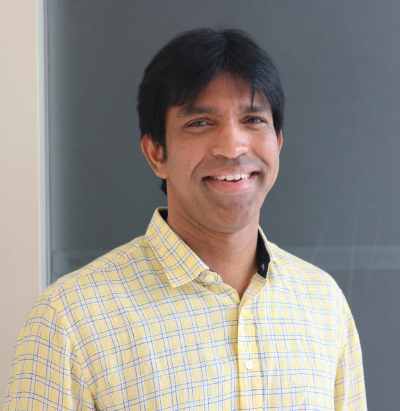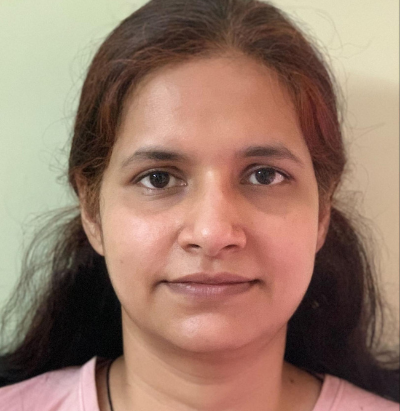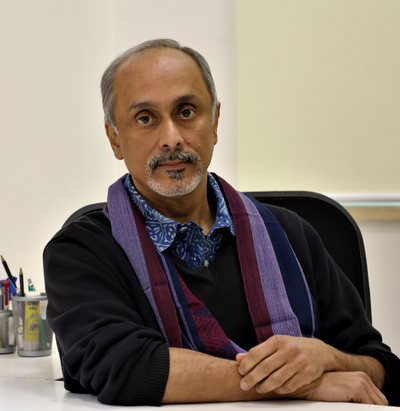Condensed Matter Physics and Biophysics
Research in condensed matter physics explores the physical properties of matter in regimes where the interactions between constituent particles are significant enough to lead to collective behaviour. Modern condensed matter physics, both experimental and theoretical, includes quantum mechanical systems as well as systems that can be understood largely through classical physics. It includes the study of magnetism, semiconductors and superconductors, focusing on elucidating fundamental phenomena including collective excitations, topological order, and quantum phase transitions. Soft condensed matter physics, sometimes called the physics of complex fluids, investigates materials that are easily deformable. Such systems exhibit novel and often nonlinear flow properties. They include polymers, colloids, gels, fluids and liquid crystals. These can be modeled using tools of statistical mechanics.
The field of biophysics has important overlaps with the study of soft condensed matter physics, statistical physics and complex systems. Theoretical and computational biophysics leverages and generalizes approaches from these fields to study biological systems, including the structural and dynamical properties of biomolecules, often integrating concepts from statistical physics and molecular dynamics. Complex systems science studies the emergent properties of systems with many interacting units, developing methodologies that generalize across many disciplines.
For a complete list of publications, please click here
I. Experimental Condensed Matter Physics
Magnonics is a rapidly evolving field of research that promises to revolutionize information technology by enabling a new generation of energy-efficient devices. At its core, magnonics leverages spin waves—the quanta of collective spin excitations, or magnons—as carriers of information in the microwave frequency regime. Unlike conventional electromagnetic waves, spin waves have much shorter wavelengths at the same frequency. For instance, at 20 GHz, spin waves can have wavelengths as short as 100 nanometers. This dramatic size difference makes them ideal candidates for nanoscale, on-chip microwave signal processing and the development of compact nano-magnonic devices.
Research at Ashoka in this area tackles some key challenges in magnonics—from addressing fundamental scientific questions to engineering low-loss spin-wave-based devices. This work will help pave the way toward practical applications of magnonics in future information processing technologies.
Magnetism
Magnonics is a rapidly evolving field of research that promises to revolutionize information technology by enabling a new generation of energy-efficient devices. At its core, magnonics leverages spin waves—the quanta of collective spin excitations, or magnons—as carriers of information in the microwave frequency regime. Unlike conventional electromagnetic waves, spin waves have much shorter wavelengths at the same frequency. For instance, at 20 GHz, spin waves can have wavelengths as short as 100 nanometers. This dramatic size difference makes them ideal candidates for nanoscale, on-chip microwave signal processing and the development of compact nano-magnonic devices.
Research at Ashoka in this area tackles some key challenges in magnonics—from addressing fundamental scientific questions to engineering low-loss spin-wave-based devices. This work will help pave the way toward practical applications of magnonics in future information processing technologies.
Involved faculty: Susmita Saha
Focused research areas are:
- Spinwave dynamics of magnetic metamaterials such as magnetic fractals and artificial spinices
- Ultrafast magnetization dynamics of various magnetic materials and thin films and hetero structure
- Synthesis of magnetic nanoparticles and nanowires and their applications in magnonics
- Study of spinwave dynamics of nonlinear spin textures such as magnetic Skyrmions and Vortices,
Facilities Available:
- RF-DC Sputtering Unit,
- Magneto optical Kerr effect microscope (MOKE),
- Vector network analyzer based Ferromagnetic resonance set up (VNA-FMR),
- Electrodeposition Unit,
- Computers to analysis the data and perform micromagnetics simulations
National/International Collaborations:
- Prof. Anjan Barma, S. N. Bose National Centre for Basic Sciences, Kolkata, India
- Prof. Maciej Krawczyk, Adam Mickiewicz University, Poznan, Poland
- Dr. Ronny Knut, Uppsala University, Sweden
- Prof. Dario Arena, University of South Florida, USA
- Details could be found in : https://susmitamagnonics.weebly.com/collaborations.html
Soft matter physics (experiment)
Our research focuses on understanding the physical phenomena in soft (and active) matter with the aid of experimental tools including electro-optical techniques, microfluidics, advanced imaging and image processing. Soft matter phase is the outcome of a fine balance between internal energy, thermal fluctuation and entropy. As a result, small external perturbations/ stimuli can bring about a large change in its spatio-temporal behaviour. We are interested in deciphering the physical mechanism of such phenomena experimentally. Our group is currently working on the following projects.
- Electro-magneto-optical studies in twist-bend nematics: Twist-bend nematic (NTB) – a nematic phase composed of achiral curved dimers by filling the space with uniform twist and bend distortion – is one of the most important discoveries in the field of liquid crystal in the last decade. This new discovery revived the interest of the researchers working on both basic and applied aspects of liquid crystals. While liquid crystal chemists have since been focusing on designing new materials keeping molecular structural properties as guiding principles that could potentially exhibit the NTB phase, physicists have been trying to understand physical principles behind the stability of this phase and its signatures. As it stands now, there are discrepancies between the theoretical models and the experimental observations. For example, theoretical models predict continuous N–NTB transition whereas experimental reports indicate that N–NTB transition is weakly first order. Similarly, the theoretical models require splay and bend elastic constants to be of the same order of magnitude in the nematic phase for materials exhibiting NTB phase at lower temperature; but the experimental data suggest that splay elastic constant is 20 times larger than the bend elastic constant. Inspired by these anomalies, we are investigating the domain growth dynamics of the N → NTB phase transition close to the transition temperature by employing polarized light microscopy imaging technique. We are trying to measure the relative strength of the splay and bend elastic constants by analysing the decay dynamics of wall textures induced by the sudden application of magnetic fields. We would like to measure these quantities by different techniques such as dynamic light scattering, electric (and magnetic) Freedericksz transition etc for many different liquid crystal compounds that exhibit a stable NTB phase.
- Involved faculty: Pramoda Kumar
- People involved: Ankit Gupta (PhD student) and Pushkala Devi (Project associate)
- Collective dynamics of C. elegans: Collective behaviour of self-propelled organisms – from bacteria to ants to birds – exhibit some commonality, and have been model systems to verify some of the interesting ideas of non-equilibrium statistical physics. In our study, we use C. elegans as a model organism to examine collective dynamics in two-dimensional environments. These nematodes are particularly interesting due to their elongated flexible bodies and ability to move in both directions. Experiments with varying number density show interesting spatio-temporal patterns and complex coordinated motions. Our approach relies heavily on image analysis, computer vision, and machine learning techniques to extract and interpret complex dynamical patterns from experimental data.
- Involved faculty: Pramoda Kumar
- People involved: Shri Gowri Tikoti (PhD student), Simar Randhawa (undergrad) Yahya Ashraf (undergrad, SNIoE)
- Experiments with shear thinning fluids motivated by creep instability in glaciers: It is an observational fact that once a glacier starts sliding, it slides easily and quickly (glacier surge), in some sense behaving like a shear thinning non-Newtonian fluid. It is also theorized that the underneath ice melts because of its own weight, and this water (ice slurry) acts as lubricant. The goal of this project is to design a table-top experimental setup and use a shear-thinning non-Newtonian fluid (Xanthan gum solution) as a model fluid to mimic the glacier and lubricate it with salt water. Further, we perform the same experiment with a non-Newtonian fluid as lubricant to find out which of the two systems resembles the glacier flow instability better. We form a large drop of the Non-Newtonian fluid at a constant flow rate on a glass substrate kept parallel to the ground; this ensures the circular spread of the drop on the substrate. At some point, we inject the second fluid from below. We hope to capture some of the salient features of glacier flow (instability) in our experiments by systematically scanning the control parameter phase-space.
- Involved faculty: Pramoda Kumar
- People involved: Susanta Ghosh (Research assistant) Drishana Kundu (undergrad)
Major Experimental facilities:
- Polarized light microscope with all accessories for electro-optical measurements.
- Custom-made Magneto-optics setup
- Active Vibration-isolation optical bench
- Stereo-microscope
- LRC meter
- Linear voltage amplifier
- Lock-in-amplifier
- Precision microscope hot-stages.
- High-end digital oscilloscope
- Spin-coating and rubbing machines for liquid crystal cell fabrication.
- Programmable syringe pumps
- Programmable weighing balance
- Hydrodynamic experimental facility.

Assistant Professor of Physics, Ashoka University
Ph.D. S. N. Bose National Center for Basic Science, India

Assistant Professor of Physics, Ashoka University
Ph.D. CeNS, Bangalore
II. Condensed Matter Theory
- Quantum phase transitions: Current interest is in a class of nonequilibrium phenomena in quantum systems that show phase transitions and scale invariant behaviour in time, generally after a quench of parameters. The real-time evolution of physical quantities offer deep insights into quantum dynamics, decoherence, and the structure of quantum states far from equilibrium. They represent a frontier in understanding how quantum systems evolve and reorganize under time-dependent perturbations.
- Involved faculty: Somendra Mohan Bhattacharjee
- Polymers, phase transitions: Studies involve equilibrium and nonequilibrium phase transitions in complex systems like polymers, the effects of topological constraints, growth problems like surface growth, pattern formation in ecological systems like ordering and defects in insect nests. Unlike small molecules, long and flexible polymer chains can easily entangle, loop, or knot, leading to topological constraints that affect their movement, stretchability, and response to forces. Understanding these effects is particularly important in biology.
- Involved faculty: Somendra Mohan Bhattacharjee, Garima Mishra
- Magnetic properties of superconductors: Type-II superconductors allow the penetration of magnetic flux into them in the form of quantized lines of magnetic flux. The theoretical description of this uniquely quantum mechanical phenomena led to a Nobel prize for A. Abrikosov. Understanding the structure of such flux lines, relating experiments to theoretical descriptions, is the core of work in this area. This includes the modelling of the long-standing problem of the peak effect in superconductors, the interpretation of the exotic vortex glass phase and the understanding of the results of muon-spin rotation experiments in this phase.
- Involved faculty: Gautam Menon

Professor of Physics Ashoka University
Ph.D. Carnegie Mellon University

Assistant Professor of Physics, Ashoka University
Ph.D. Banaras Hindu University, Varanasi

Dean, Research and Professor of Physics and Biology, Ashoka University
Ph.D. Indian Institute of Science, Bangalore
III. Theoretical and Computational Biophysics
Biophysics is fundamental in deciphering the core physical principles that govern biological systems at the molecular and cellular levels. This interdisciplinary field employs rigorous quantitative methods, such as statistical mechanics and computational modeling, to uncover the mechanisms behind essential life processes like genome maintenance and gene regulation. By providing critical insights into DNA dynamics, protein-DNA interactions, and cellular mechanics, biophysics establishes a foundational understanding of life’s basic processes.
DNA and protein structure and dynamics:
-
- DNA Melting and unzipping focuses on modeling the separation of base pairs to investigate DNA replication, transcription initiation, and how thermal fluctuations and force-induced strand separation affect these processes. It offers valuable insights into the structural properties of DNA.
- Involved Faculty: Garima Mishra and Somendra Mohan Bhattacharjee
- Protein-DNA interactions investigate how proteins bind to DNA, shedding light on binding affinity, search dynamics, and gene regulation mechanisms, while DNA translocation examines the movement of DNA through nanopores and membrane channels, with relevance to gene delivery and nanopore sequencing.
- Involved Faculty: Garima Mishra
- DNA Melting and unzipping focuses on modeling the separation of base pairs to investigate DNA replication, transcription initiation, and how thermal fluctuations and force-induced strand separation affect these processes. It offers valuable insights into the structural properties of DNA.
Facilities Available: HPC cluster with GPUs.
National/International Collaborations: Garima Mishra: Prof. Sanjay Kumar, Banaras Hindu University, Prof. Amar Nath Gupta, IIT Kharagpur, Prof. Navin Singh, BITS Pilani, Prof. Koby Levy, Weizmann Institute of Science, Israel.
Biophysics of the cell
The understanding of the physical properties of the nucleus of cells, including how chromosomes are distributed within it, is a line of active work. Using methods from the statistical physics of active systems to understand, model and simulate cell-level phenomena is a major interest.
Involved Faculty: Gautam Menon
National/International Collaborations: Gautam Menon: K Vijay Kumar – ICTS; Sandhya Koushika: TIFR, Mumbai; Namrata Gundiah – IISc, Bengaluru; Pramod Pullarkat – RRI, Bengaluru; Mandar Inamdar – IITB, Mumbai

Assistant Professor of Physics, Ashoka University
Ph.D. Banaras Hindu University, Varanasi

Professor of Physics Ashoka University
Ph.D. Carnegie Mellon University

Dean, Research and Professor of Physics and Biology, Ashoka University
Ph.D. Indian Institute of Science, Bangalore
IV. Complex Systems
Computational and mathematical epidemiology
Modeling the spread of infectious disease using modern mathematical and computational models is an example of how complex systems science finds application in the field of epidemiology. An ultra-large-scale agent-based computational model has been developed that is being used to investigate how outbreaks and epidemics of infectious disease are initiated and the nature of the interventions (vaccinations, quarantines etc.) that can be used to curb them. Agent-based and network models are important tools in complex systems studies and BharatSim represents a cutting-edge application of these tools. Another area of interest is studying the impact of climate change, especially in the area called One Health, which ties together human, animal and ecosystems health.
Involved Faculty: Gautam Menon
National/International Collaborations: Brian Wahl and Bhramar Mukherjee – Yale University, USA; Sandeep Krishna – NCBS, Bengaluru; Sitara Ajjampura – CMC, Vellore; Anand Krishnan – AIIMS, Delhi; Saumyadeep Bhaumik – George Institute, Delhi; Lancet Commission on the Modeling of Infectious Diseases

Dean, Research and Professor of Physics and Biology, Ashoka University
Ph.D. Indian Institute of Science, Bangalore





